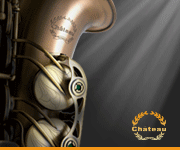 Forgot Username? Forgot Password?
Forgot Username? Forgot Password?
 LeBlanc's History
LeBlanc's History
This is a history of the people behind the name Leblanc, a personal account of the most magnificent and respected family in the history of musical instrument manufacturing--a family whose devotion, foresight and ideals are the inspiration of our industry. The Leblancs are a unique combination of musical artistry, acoustical and engineering genius, progressive thought, with a deep-seated dedication to music and musicians. In 1959, in the Noblet factories in La Couture-Boussey in the French province of Eure, you would have found the grand old gentleman of the French woodwind industry, "Papa" Georges Leblanc, busily creating new improvements and new models just as he had for over half a century. And by his side you would have found his inspiration for all these years, "Mama" Clemence Leblanc, who worked every day hand-wrapping clarinets with the same care and pride that she had for over fifty years. During World War I, Mama Leblanc actually ran the factory while her husband was in the service of his country. Her technical knowledge of manufacturing processes was undoubtedly greater than the heads of competitive manufacturers. In 1959, Georges and Clemence's son, Leon, was the active head of G. Leblanc Cie., Paris. He had the rare qualities of brilliance in music, acoustics, instrument design and engineering, that comes along only once in a generation! He was the only active head of a musical instrument manufacturing company that won the coveted "Grand Prix" at the Paris Conservatory. He was indeed a great artist!
Leon Leblanc learned the art of instrument making from his father and mother. Even before he had reached his teens he had become familiar with virtually every aspect of the instrument-maker's craft.
As is traditional in the Leblanc family, Leon began his purely musical training at an early age--first on the soprano saxophone and then on the clarinet. He began in this order because his fingers were too small to cover the rings on the clarinet. This fact eventually led Leon to develop the covered tone hole or plateau-key Bb clarinets and alto clarinets, and to further improve the Eb soprano clarinets, so that other young musicians would have a solution to this problem.
While still in school, Leon Leblanc's outstanding talent was recognized by one of the great French conductors of his day, Phillippe Gaubert, who insisted that Leon be entered in the Paris Conservatory. Here he completed his studies and graduated, winning the first prize both in clarinet and in solfeggio.
Following his graduation from the Paris Conservatory, Leon Leblanc followed a successful career as a concert clarinetist. He felt that an even greater contribution could be made to the art of music by combining his talents as a musician and an instrument-maker. Leon's friends know of his great love for playing the clarinet and for him to give this up meant a personal sacrifice in order to help others.
As an artist-musician, he knew the many problems that confronted an instrumentalist due to technical shortcomings in the instrument itself. He considered the clarinet to be an integral part of the player--an extension of his voice that must be flexible enough to express music in every form and mood. It must take the human element into consideration. With this knowledge and belief, he devoted his life to the improvement of wind instruments so that musicians after him would not have to face the performance problems that are so great with earlier designed instruments. In this way musicians could devote their skill to the interpretation of music and the development of technical versatility rather than fighting to overcome the shortcomings of the instrument. He abandoned professional playing, which he loved dearly, and together with his father opened a factory in Paris for the express purpose of developing new and improved instruments and instrument-making techniques.
In history, the manufacturer of instruments most always takes the level that he has achieved as a performer. A fine player understands the problems of emission, tuning, resonance, intonation, interval tuning, dynamic control, control of pitch for production of crescendos and diminuendos, the intensity of tone at all levels and numerous other things that make up music. One also must remember that if you were to scientifically analyze music you would find it is in reality organized molecular vibrations. The difference between noise and tone is that music is organized vibrations and noise is unorganized molecular vibrations.
G. Leblanc Cie., of Paris, and its associate firm, Ets D. Noblet, date back over 260 years to 1750, when the Noblet firm was founded. Members of the Leblanc family itself have been engaged in the manufacture of musical instruments from the early 1800's.
The present Leblanc organization took shape when Georges Leblanc purchased the Noblet firm in 1904.
Georges Leblanc had already earned the reputation of being the most highly skilled woodwind-maker in all of France and enjoyed the respect of instrument-makers the world over for his outstanding contributions to the art. The most significant of Georges Leblanc's early inventions was that of a precision machine for the location and drilling of woodwind tone holes. The perfection of this invention put the Leblancs far ahead of their competition--both in the quality and quantity of their output. In industry, technique is the collective experience of men and machines
Leblanc headquarters in Paris was the meeting place of the great artists -- who came to discuss their advanced ideas on instrument design, and to follow the experimental work to which the Leblancs devoted such a large part of their time. The Leblanc acoustical department was the first full time department of its kind for a manufacturer.
In all their work the Leblancs were guided by scientific principles and their own innate sense of what would be musically correct--seldom if ever by mere "trial and error." Given a certain sound vibration to produce on a wind instrument, Georges and Leon Leblanc were able to determine unerringly and by deductive methods alone, the exact location of the tone hole, its size, the amount of undercutting and the many other factors that enter into producing tone with beauty and clarity.
Together with their chief acoustician, Charles Houvenaghel, they perfected the Bb mechanism clarinet, the Leblanc contrabass clarinet -- and even built what they called an Octo-bass clarinet, pitched two full octaves below the Bb bass clarinet. They introduced the now famous Leblanc side trill keys, or "Jump Keys" as they became known. They developed the first bass clarinet with automatic register key, first covered hole alto clarinet and the first bass instrument with the adjustable neck. The Leblancs incorporated into all their instruments the principle of individual post mountings, believing that the ideal instruments should not only be musically correct but should be easy to maintain in proper regulation. These and many other Leblanc developments, including the Leblanc system saxophone, the Leblanc alto and bass clarinets and many other inventions and creations, had patents issued in many countries throughout the world.
Up to the end of World War II, Leblanc's actual output of instruments was very small --and many of these were special models created to meet the needs of artists who would come from all parts of the world for their specialized instruments. They cherished this reputation for being "the clarinetists' clarinet maker," and never let anything interfere with research and experimentation which always played such an important part in their work.
The Leblancs were fortunate in surviving the 2nd World War with vast stocks of choice grenadilla wood entirely intact, and with the end of hostilities they began production of instruments on a far larger scale.
In 1944, if one were to have visited the Noblet factory, one would be greeted by a charming, hospitable gentleman - Leon Leblanc, himself - who would cordially gave you the "deluxe tour" of these fine plants. One would be astounded at the great difference between these factories with their modern machinery and remarkable production facilities, as compared to the antiquated facilities and techniques of the other so-called major band instrument manufacturers. The following will help to explain why the Leblancs established their own factory in America.
All wood-bodied instruments made in Europe are faced with the same problems in North America. The bore changes a few weeks after an instrument has been shipped overseas. This is partly because of difference in the atmosphere and humidity between Europe and America. When the bore changes it, of course, affects the length of the molecular vibrating column. Once an instrument is designed and made properly, one of the many reasons for bad intonation comes from the bore changing.
In order to take care of this problem Leblanc felt the only thing to do would be to establish their own factory in America. Then they could control the work being done and educate their American associates to the musical importance of having instruments made, finished and delivered in proper playing condition. This was a tremendous undertaking with a substantial risk. Even though Leblanc had to gamble their fortune, they would not compromise.
It was necessary for Georges and Leon Leblanc to redouble their efforts--to keep up their program of improvements to the instruments themselves, and at the same time to institute new precision fabricating methods in an attempt to keep up with the new demands for Leblanc instruments. They never hesitated to change fabrication methods when they knew it would mean a better instrument--at the same time always guiding themselves from the experience of the past.
For all their concern with craftsmanship, the Leblancs were still primarily musicians and it was their feeling of responsibility toward the musician and toward the future of music which gave them the courage to make the huge investments in plants, machinery, tools, dies and jigs, and personnel necessary to their own unique methods of precision fabrication. These investments have proven their value in the quality and the uniformity which Leblanc is able to achieve, and are continually setting examples that have materially raised the standards of the entire band instrument industry and will continue to contribute even more in the future. Leblanc's goal, therefore, is to introduce new concepts of quality--both mechanically and from a performance standpoint, and to help build for a better world of music today and for generations to come.
In 1959, Leblanc was the only manufacturer that made the complete clarinet family in production. This included the Ab sopranino, the Eb, C, Bb and A sopranos, F alto standard range, F basset horn ranged to C, Eb alto, Bb Bass Normal range, Bb bass extended range to C, Eb contra alto with extended range to C, Bb contrabass, Bb contrabass extended range to C.
No other manufacturer could match the tooling, machinery, plant and equipment investment of the Leblanc family.
In manufacturing, model changes required big investments. Between 1944 and 1959, Leblanc created more new models than all the other makers combined. In the soprano, alto, and bass family, each instrument was substantially refined over the previous model. This is certain proof of Leblanc's never ending search for improvement and refinement.
Georges Leblanc long ago set the principles of integrity, musicianship, and creativity as the basic principles that he and his family and his firms would live by.
LEBLANC "FIRSTS"
In order to truly understand and appreciate the ability, foresight, and genius of such men as Georges and Leon Leblanc, Charles Houvenaghel, and others responsible for the greatness of Leblanc, one need only look at the long list of Leblanc "firsts" in inventions and improvements. It has been said, and rightly so, that the only major changes made on the clarinet from 1909 to 1959 were made by Leblanc. Though some of these improvements have become public domain and are used by most of the clarinet manufacturers today, the same untiring efforts for perfection insured Leblanc's continued leadership in the clarinet making field. The many patents and significant firsts in the art of woodwind design made Leblanc a leader in acoustical research and mechanical design.
The origin of this phase of the Leblanc story began in 1904 when Georges Leblanc started to produce instruments bearing his own trademark. In cooperation with the eminent artist and acoustician, Charles Houvenaghel, they began a research and development program. The results were the creation of the complete clarinet family and more basic improvements mechanically and acoustically to the clarinet family than any other instrument manufacturer in history.
One in a long series of inventions (Patent #2,821,102) was a neck attachment for alto and bass clarinets. The attachment was a metal sleeve which joins the wooden body and neck. Within the sleeve was an insert of resilient or elastic material that takes up differences or variations in size due to relatively different dimensional changes between the wooden body and metal insert as a result of temperature and moisture fluctuations. This helped eliminate the cracking and air leakage which occured as a result of the opposing coefficients of expansion.
Because of the concentration of moisture at this point, the new type sleeve was a vast improvement over the conventional method of joining the upper joint and gave the music industry a bass and alto clarinet that was 75 to 90 percent less susceptible to the cracking that might normally occur at this point.
The next great improvement was to the alto clarinet. Not only did Leblanc apply the patented invention of the automatic register key but they invented the first alto clarinet which had all covered tone holes. Before that time the alto clarinet had either a combination of covered holes and rings, or all rings. In reality, the instrument was practically impossible to play because the holes were too large in diameter to cover with security, and also the positioning of the holes required an extraordinary large hand making the instrument very awkward to play indeed.
Two other patents’ purpose (#181,660 and #2,833,175) was for the improvement of the neck design and the body of the alto clarinet. The new "Swan-neck" had a double bend, as versus the single curve of previous alto clarinet models. Accordingly, it allowed the clarinet to be held substantially higher, thereby facilitating holding and playing of the clarinet without tiring the clarinetist, and the body of the clarinet could be held parallel to the body of the clarinetist without requiring an awkward head or mouth position. It also greatly shortened the arm reach necessary to play some of the lower notes, raising the hand positions approximately 2-1/2 inches. This afforded a much more comfortable "feel" and greatly facilitated the execution of technical passages. The mouthpiece then entered the mouth at very nearly the same angle as that of a regular Bb soprano clarinet.
Obviously, many more improvements have been made on Leblanc instruments since the writing of this document….
Adapted from the 1959 copy of the Leblanc Sales Manual.




